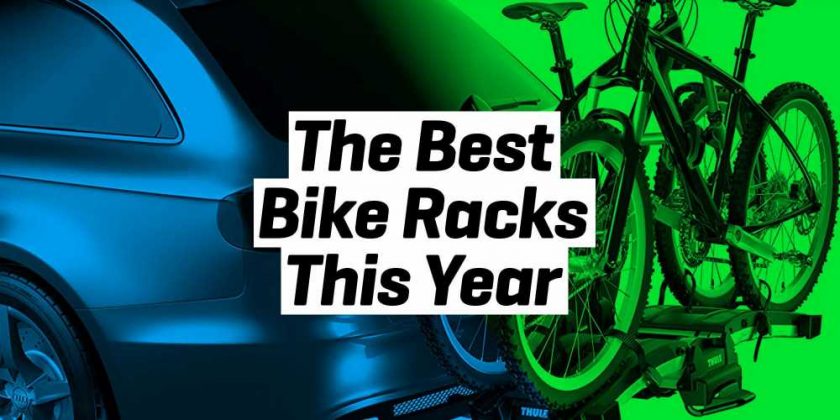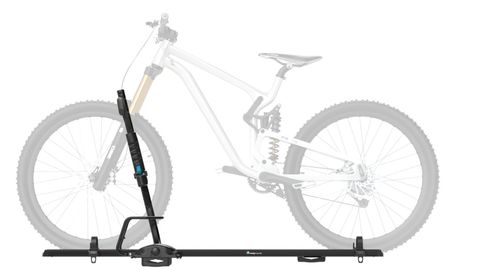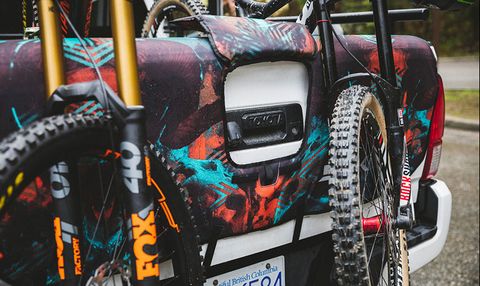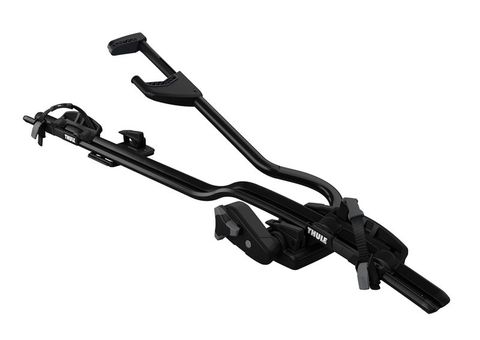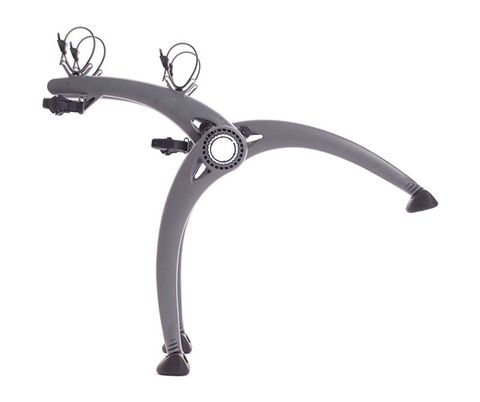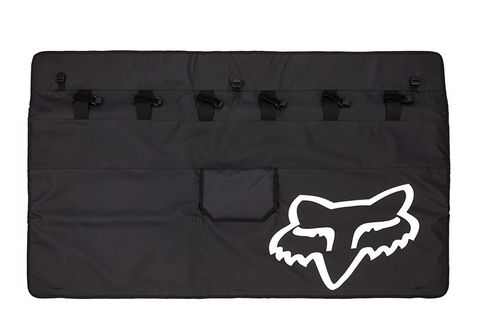There are a vast number of bike racks on sale today, all variations of the same idea with the same end goal: to safely transport your bike to your destination without having to contort it to fit inside your vehicle. Some racks attach to become semi-permanent extensions of your car (think hitch and roof), while others are designed to be more portable (trunk or tailgate pad).
Some, like the Thule ProRide XT, for example, attach to factory crossbars on a roof, while others—like the Saris Bones 2-Bike—hook onto your trunk and can be removed when not in use. The best rack for you will depend on a few things: the type of mount (your car may not have a hitch), the type of bike (all racks come with weight limits), tire size (if you want to haul a fat bike, keep that in mind), number of bikes you want to carry (most racks accommodate two), and your budget (the racks in this list range from $150 to $1,395). First decide what kind of rack you want, then narrow down within that category to find the right one for your needs.
Scroll down for a snapshot of four of the best racks, then keep reading for buying advice and in-depth reviews of these and other great options.
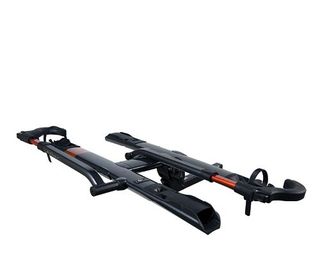
A hitch cam tightens the rack in the receiver tube for jiggle-free connection.
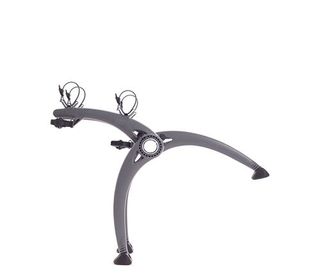
Quickly adjusts without tools to fit the contours of your vehicle
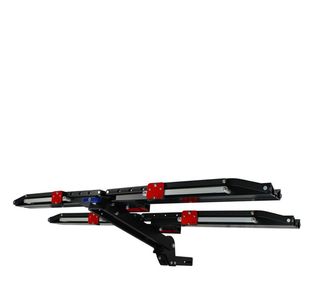
Ratcheting arms eliminate the need for straps.
Roof Racks
There are three types of roof racks: complete rack systems that mount to your bare roof, trays that attach to your factory-installed crossbars/side rails/tracks, and suction cups that vacuum seal to almost any surface. And there are two ways to carry bikes on them: with or without the front wheel attached. Remove the wheel and you lower the height and lighten the bike, but that may not be so easy with some disc-brake-equipped bikes. Adapters are available for thru-axles, though it’s wise to check compatibility before you buy. Leave the wheel on and you eliminate any concern regarding disc brakes and having to stash a muddy tire in your car, even if you sacrifice a bit of stability. Other bonuses for using a roof rack: On most options, everything locks (bikes to rack, rack to roof), and there’s no chance of a damaged bike should you get rear-ended on the highway. But there is a chance you’ll forget that your bike is up there as you pull into the garage, so beware.
Hitch Racks
Of the three styles here, the hitch rack is the most convenient. Once it’s installed, nothing more needs to be done, and lifting bikes up and onto the trays (or, in some cases, hanging them from the top tube) is easier than lifting them over your head the way you do with a roof rack. Hitch racks slide into your vehicle’s receiver tube, and most are available for 1.25 and/or 2-inch receivers. Most newer options lock to your hitch, are hinged to fold up and out of the way when not in use, and have a cam to firm up the rack inside the receiver tube for a jiggle-free connection. Many also now have an integrated lock to secure bikes to the rack and use arms that extend up and over the front wheel. A downside to hitch racks: They extend the length of your car, so you’ll have to be extra cautious when backing up and parallel parking.
Trunk Racks
This type of rack attaches to your trunk using straps and hooks, and upper and lower feet stabilize it against the car. It’s typically the cheapest and lightest option of the three and the most portable. Once you get the hang of how the straps and hooks work with your car, removing and installing the rack becomes easier. And if you park in a high-crime area, you’ll want to remove it and stash it inside your car or house (trunk racks don’t lock to your car). Other downsides include the potential for a pedal or wheel to flop around and scratch your car’s paint, limitations with where the hooks attach (weather stripping and spoilers may present a problem, for example), and that it may not work with some funky-shaped bikes (think mountain bikes) since it holds them up by the top tube.
Tailgate Pads
A tailgate pad, which attaches to and covers both sides of the tailgate on your pickup, lets you safely drive with multiple bikes (up to seven with the Dakine Pickup Pad). Simply drape the pad over the tailgate and attach it via a series of webbing straps that loop around the gate. Load bikes in rear-wheel first so only the front wheel hangs over the tailgate, and use the looped straps to secure each bike by its down tube. The grooves in the bed liner act as natural trays for the rear wheel.
How We Tested These Racks and Pads
Our bike-crazed editors have driven hundreds and, in some cases, thousands of miles with their bikes entrusted to these racks. We research the market, survey user reviews, speak with product managers and engineers, and use our own experience to determine the best options for you. We haul road bikes, mountain bikes, e-bikes, and city bikes, as well as bikes with disc brakes, big wheels, fat tires, and more. We keep these racks and pads on our vehicles for months, using and abusing them until we know what works and what doesn’t. If we weren’t satisfied with a particular rack, we didn’t include it. So far, these are the 17—divided into roof, hitch, trunk, and tailgate categories—that earned their spots as the best.
Why It May Be Harder to Find a Rack Right Now
Ever since terms like “shelter in place,” “stay at home,” and “social distancing” took root in our daily lexicon, we’ve had to find alternative forms of entertainment that don’t involve large crowds, indoor activities, or risky situations (such as travel). More people have caught on to the idea that outdoor escapes like hiking, running, and bike riding are safe, sanity-saving ways to get out and do something—away from others. This has led to a surge in bike and bike accessory sales and, thus, a depletion of stock. That’s a good thing, because it means more people have discovered bikes. But it’s also frustrating if your goal today is to place an online order only to find out that you may have to wait weeks or even months to get it. If you see something on this list that catches your eye, and you hit the out-of-stock roadblock, patience (waiting until inventory is fulfilled again), perseverance (it may be available somewhere else online or even somewhere locally), or just being proactive (pre-order is available for many out-of-stock models) might be the way to go. We’ll keep our eye on inventory and update links as often as we can.
Roof Racks
―MOST VERSATILE―
SeaSucker Komodo
Shop Now
The Komodo doesn’t look or operate like a traditional roof rack, but our tester thought that was a good thing. Designed to work with either thru-axles or quick releases, it attaches to the roof of a car with four “vacuum cups” that are locked into place by repeatedly pressing the plunger on the side of each until the orange band isn’t visible. To release it, simply pull up on the tabs of each cup and remove the rack. Our conservative tester reached speeds of over 60 mph on the highway, while a more adventurous SeaSucker user put the pedal to the metal on the Autobahn. Neither had any noticeable issues. A bonus is the rack can be fixed to any surface on which you can get a vacuum seal—it doesn’t have to be just the roof, the trunk and back of van doors are also fair game. SeaSucker claims there shouldn’t be any issue with where you place the rack on your roof, but the company cautions against adhering it to any area that’s prone to flexing a lot. While it doesn’t explicitly advise not placing the rack completely on a sun or moonroof, you may want to avoid testing the strength of your windows, and at least fix the front cups to the metal portion of your roof. Still, the only true downside is there’s no way to lock you bike to guard against theft.
―BEST FOR TRAVEL―
SeaSucker Talon
Describing the SeaSucker Talon as a roof rack, while accurate, doesn’t quite do justice to the versatility of this diminutive bike rack. In truth, you can mount the Talon, or any SeaSucker for that matter, to any glass or metal surface you can get the vacuum cups to seal onto. This means complete freedom to place the bike anywhere on your car that you desire. On large vehicles you can tetris in many bikes because of the lack of restrictions on placement, and on small sedans you can place the fork mount on the roof and the wheel holder can be on the rear window. You can even attach this rack to the back of van doors. If you travel for a race, stash this rack in your duffel bag and you’ll have a bike rack to put on your rental car. The options are virtually endless. What you can’t do is lock this rack to your car or your bike to the rack. But for the price and convenience, this little rack is the best option for anyone who only needs a rack some of the time.
―WHEELS-ON ROOF RACK―
Thule ProRide XT
If you don’t like removing wheels but still want your bike to ride on the roof, the Thule ProRide XT is a great option. It will easily accommodate gravel, road, mountain, and cyclocross bikes, to name a few. And with the addition of the fat bike adapter it can also work with tires up to five inches wide. The clamp mechanism holds onto the down tube, tightens with a dial, and works with a wide variety of tube cross sections. Thule states a maximum load capacity of 44 pounds; if your e-bike is lighter than that, and you’re comfortable heaving it onto the roof, this rack will work for you. But don’t forget that mounting a bike on top of your car with both wheels on adds significant height to your vehicle, making drive-through windows and garages hazardous to the health of your beloved bike.
Hitch Racks
―MOST ADAPTABLE―
1UP Equip-D Double Rack
1Up has built a cult-like following with its industrial-looking racks that take a simplistic approach to securing your bike. Two ratcheting arms clamp down on your wheels—no hooks, straps, or adjustments for different sizes or bases necessary. This one specifically features wider and taller arms to work better with 29-inch wheels and fat tires. The Equip-D’s pivot mechanism is smoother, and a T-handle release positioned at the end of the hitch bar doesn’t require reaching through the rack to fold it up. Tiered trays allow bikes to sit closer together, and the rack rides high enough to be out of the way of most exhaust pipes.
―BEST VALUE DOUBLE―
Küat Sherpa 2.0
You’re officially free to forget every complaint you’ve ever had about hitch racks. The Küat Sherpa 2.0 is as intuitive and convenient as it is sturdy and stylish. Available for both 1.25- and 2-inch hitch sizes and in three colors, the Sherpa pivots up and down with ease via a large lever and fits two bikes (max: 40 pounds each, 47-inch wheelbase, 3-inch tires) on its lightweight aluminum platform. Assembly is fairly simple (make sure you follow the directions when removing parts, as the packaging acts as an assembly fixture), and a hitch cam lets you hand-tighten the rack to the receiver for a secure connection. Loading bikes on the trays is a breeze: A ratcheting strap secures the rear wheel in its cradle, while an adjustable, hooked arm battens down the front. The entire system locks to your hitch, and a semi-integrated cable lets you lock your bikes to the rack.
―BEST ACCESSORIES―
Küat NV 2.0
The last thing you want to see in your rearview mirror as you hurtle down the road is thousands of dollars worth of bikes rattling behind your bumper. Thanks to an expanding-wedge design that secures the rack in your vehicle’s receiver hitch and locks in place with a theft-preventing thru-bolt, the NV 2.0 stayed wobble-free throughout our testing. A stout pivot lets you flip the rack up when you’re not hauling bikes, deploy it flat for when you are, or drop it to a 45-degree angle for easy access to trunks and pickup beds. Other nice features: integrated cable locks and arepair stand, and adjustable cradles that offer better clearance for stacked bikes when loaded. The only hiccup we noticed is the ratcheting system can get gunked up, making it hard to remove bikes. We also found that as long as we paid attention to cleaning dirt and grime off the ratcheting system after driving on dirty or dusty roads, that issue was eliminated entirely. The NV 2.0 is available for 1.25- and 2-inch receivers; extras include a 20-inch-wheel adaptor for $10 and the $429 two-bike add-on (for 2-inch receivers only).
―BEST UPDATE OF A TRIED–AND–TRUE FAVORITE―
Thule T2 Pro XT
It’s uncommon for a bike rack to elicit awe, but the T2 Pro XT has a series of features that make it, well, awesome. Topping the list is a handle with a wide trigger that allows you, with a single hand, to raise and lower the rack (and dip it out of the way for access to rear hatches). Integrated cable locks keep your bikes from growing legs, and the rack’s arms have a wide, comfortable grip and slide easily to secure the front wheel, with tires up to 5 inches wide. Instead of using a bolt, the T2 secures to your hitch receiver with an expansion wedge that tightens with a locking knob. The system makes installing and removing the T2 easier (though it weighs 52 pounds, so you might still need an assist), but it’s not foolproof. We didn’t read the instructions carefully enough upon installation and watched in horror as the rack slid away on a six-lane highway; amazingly the bike, the rack, and all vehicles were undamaged, and proper installation has prevented a repeat performance. The T2 is heavier and costs more than most racks, and the convenient features mean it requires a little more care. But the same was said when we moved from hardtails to full-suspension bikes, and few have looked back.
―BEST FOR TAILGATE ACCESS―
RockyMounts BackStage Swing Away
Even hitch racks that tilt down can get in the way of accessing some trunks. The BackStage solves this problem with a design that pivots the bike trays (loaded or unloaded) to the passenger side of the vehicle. While this mechanism makes the rack noticeably heavier to lift on and off your car, the extra weight is one of the only drawbacks we encountered. Quick-release, spring-loaded locking pins keep the rack secure in both the extended and closed positions, while a screw-type clamp keeps it stable and rattle-free while driving. The BackStage fits on 2-inch receivers and can carry two bikes that weigh up to 60 pounds each, with tires up to 5 inches wide. A locking hitch pin and cable-style lock deter theft.
―LIGHTER THAN MOST―
Yakima Dr. Tray
In two months of testing Yakima’s new, sturdy-yet-light Dr. Tray, we hauled everything from ultralight road bikes to a super-long, 150mm-travel plus bike to a tight-wheelbase dirt jumper. It held them securely, with little slop and sway on bumpy, switchback dirt roads. Features are well designed: The integrated locks aren’t high-security but do add some peace of mind, and the lever that tilts the rack down to provide access to your trunk is at the back end of the rack for ease of use. The Dr. Tray isn’t perfect: The wheel straps barely fit fat-bike tires, and the 80-pound total weight limit and minimum 26-inch wheel size make it less than ideal for families. But at just 34 pounds, the Dr. Tray is almost a third lighter than similar racks from other brands—helpful when you’re trying to wrestle it on and off your car. If you carry mostly adult-size bikes in various styles and remove your rack often, it’s a great choice.
―BEST FOR EXPANDING CAPACITY―
Yakima Holdup EVO
The Yakima Holdup Evo is a seriously solid bike-hauling machine; we’ve had bikes on and off of it almost every day with no complaints. The Evo handled everything we threw at it, including burly mountain bikes and extra-thick e-bikes. The optional EVO +2 two-bike add-on is easy to install and handy for extra capacity. The rack’s aluminum tubing is lightweight and feels solid, and the apparatus holds bikes confidently with minimal bouncing—when you’re done riding, the whole thing folds up nicely. The added bonus is the included bottle opener built into the end of the rack.
―STURDY DESIGN, LIGHTWEIGHT CONSTRUCTION―
Thule Helium Platform 2
Add Thule to the list of brands that have adopted the system of dual ratcheting arms made popular by 1UP. But as you’d expect from Thule, the Helium Platform 2 is polished, refined, and very user-friendly. Aluminum construction keeps it as light as possible without sacrificing load capacity. Once you wrestle it into your hitch receiver, it fits snug and secure without wiggling or bouncing. The ratcheting arms make it mindless and easy to load bikes of varying wheel base lengths, as there are no straps to adjust. Simply place the bike on the rack, push the arms over the wheels, and away you go. The only drawback with the Helium Platform 2 is the trays aren’t tiered or staggered, so you can run into fit issues from time to time, with the handlebar from one bike running into the saddle from the bike next to it. However, since there are no fixed places to mount the bikes, we found it easy to shift bikes side to side in order to fit them together when the bar from one bike ran into the rear wheel of the other.
Trunk Racks
―MOST ADJUSTABLE―
Saris Bones 2-Bike
The Saris Bones 2-Bike is a lightweight, easily adjustable trunk rack that goes on quick and stays put. At $160, that’s plenty to make it a go-to trunk rack, but Saris’s consideration of minor details makes operating the Bones 2-Bike even easier. You can adjust the position of the arms and legs quickly and without tools, thanks to the center spline design, and the mounts accommodate narrow and wide top tubes. Because it’s a trunk rack, you might not be able to mount a curvy, full-suspension bike, although the narrow profile of the arms and mounts meant we were able to haul a (full-suspension) Marin Hawk Hill 3 with ease. One of our editors, who doesn’t have a hitch on his car, commented: “I found my life was easier when using the Saris Bones 2-Bike.”
Tailgate Pads
―SEPARATION PADS KEEP YOUR BIKES SECURE―
Dakine Pickup Pad
With the Pickup Pad, the Velcro straps that wrap around the frame of your bike are held securely to the pad with a separate Velcro tab that passes through a fabric loop. They can be fully removed if you don’t need them and won’t get lost if you forget to secure the main strap after removing your bike from your truck bed. Three webbing straps with a ladder buckle keep the pad in position on the tailgate so it can be removed quickly. To keep your tailgate free of damage, the Pickup has a thick dual-density foam padding and a micro-fleece lining. And the pad comes in two sizes: The small version fits midsize trucks and has space for five bikes, and the large is for full-size trucks and can accommodate seven bikes. A flap allows access to the tailgate handle but can block your rear-view camera if it’s in that position. That said, if you have an old-school pickup, this won’t be an issue. But those with modern, wider trucks that have a camera near the tailgate handle should opt for the Pickup Pad DLX.
―BEST VALUE TAILGATE COVER―
Fox Racing Tailgate Cover
The Fox Tailgate Cover comes in two sizes (small and large) and two colors (black and camo). The small pad fits midsize trucks and holds five bikes, and the large pad fits full-size vehicles and accommodates six bikes. A series of three webbing straps that loop around the tailgate make attaching and removing the pad a three-minute operation. The Tailgate Cover’s plastic outer shell is easy to wipe down, but it doesn’t have separation pads, so bikes tend to slide a little if not secured, though none that were left unattached fell during testing.
From: Bicycling US
Source: Read Full Article
